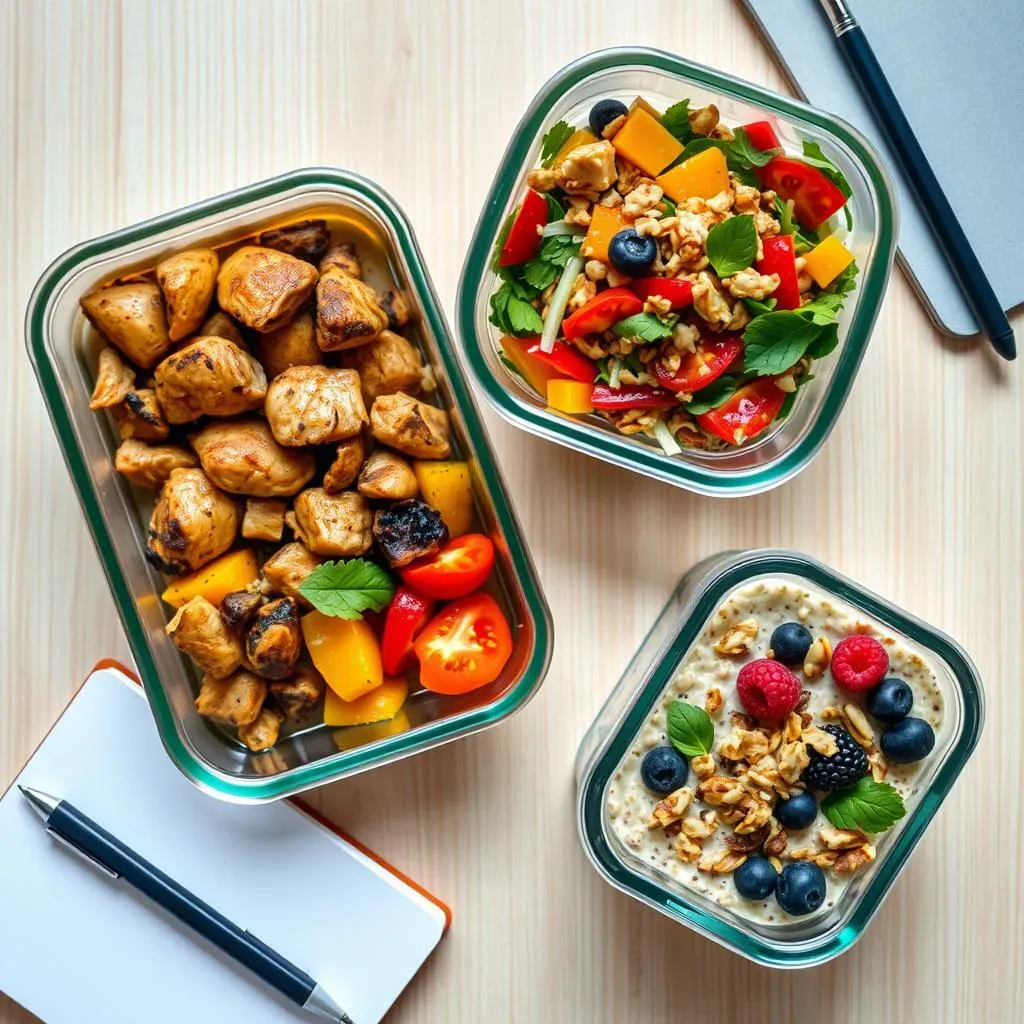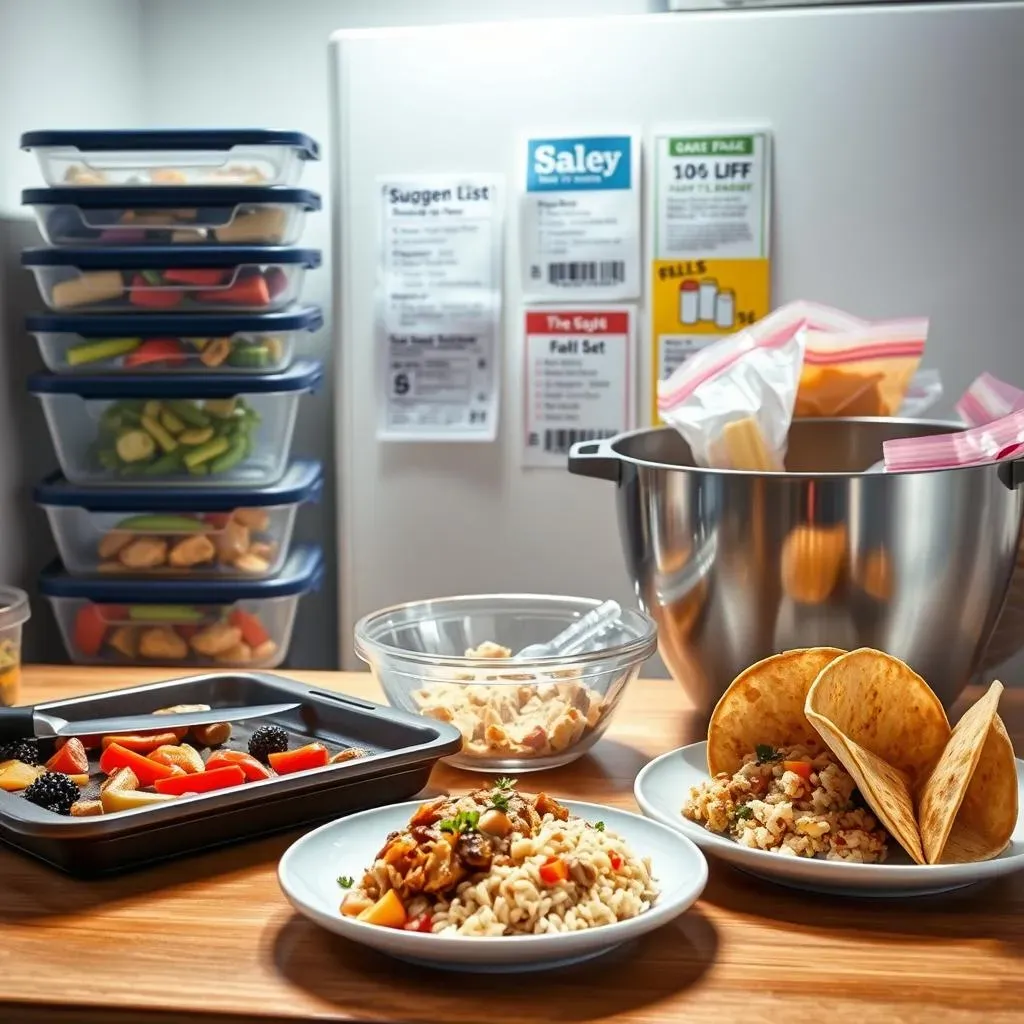Table of Contents
Juggling classes, extracurriculars, and a social life can leave you with little time to think about food, let alone cook it. That's where easy meal prep ideas for students come in! Imagine having delicious, healthy meals ready to go, saving you both time and money. This article is your ultimate guide to mastering meal prep, even with a busy schedule and limited budget. We'll explore the incredible benefits of planning your meals, from boosting your energy levels to reducing stress. Get ready to discover simple and tasty recipes perfect for dorm life, along with essential tools and smart shopping strategies to make your meal prep journey a breeze. We’ll also cover crucial tips on food storage and safety, ensuring your prepped meals stay fresh and delicious all week long. Say goodbye to unhealthy takeout and hello to a world of convenient, nutritious, and affordable meals – let's dive in and transform your student life, one prepped meal at a time!
Why Meal Prep is a GameChanger for Students

Why Meal Prep is a GameChanger for Students
Time is Money (and Sanity!)
Let's face it, student life is a whirlwind. Between lectures, study sessions, part-time jobs, and trying to maintain some semblance of a social life, who has time to cook? Meal prep swoops in as your personal time-saving superhero. Instead of scrambling for food when hunger strikes, you've got a fridge full of ready-to-eat meals. Think about it: no more impulse buys at the vending machine or waiting in long lines at the campus cafeteria. You reclaim those precious minutes (or even hours!) to focus on what truly matters – acing that exam or finally starting that side project.
Beyond the time savings, meal prep is a major stress reliever. Knowing that you have healthy, delicious food waiting for you eliminates the daily "what's for dinner?" dilemma. It frees up mental space, allowing you to better manage your workload and enjoy your downtime. No more stressing about finding a quick and affordable meal between classes – you're already covered!
Budget-Friendly Fuel for Success
Ramen noodles and instant coffee might seem like the quintessential student diet, but they're not exactly fuel for academic success (or overall well-being). Eating out or ordering takeout regularly can quickly drain your bank account. Meal prepping allows you to control your ingredients, portion sizes, and spending. By planning your meals and buying groceries strategically, you can significantly reduce your food costs. Plus, you're less likely to succumb to those tempting, but often overpriced, snacks and drinks when you have a satisfying meal already prepared.
Consider this: a single takeout meal can easily cost $15 or more. Multiply that by a few times a week, and you're looking at a significant chunk of your budget going towards food. With meal prep, you can create multiple healthy and delicious meals for the same price. That extra cash can then go towards textbooks, social activities, or even building up your savings. It's a win-win!
Benefit | Explanation | Impact on Student Life |
|---|---|---|
Time Savings | Pre-planned & pre-cooked meals | More time for studying, socializing, and hobbies |
Stress Reduction | Eliminates the "what's for dinner?" dilemma | Improved mental well-being and focus |
Budget Control | Reduces reliance on takeout and impulse purchases | More money for other essential expenses |
Healthier Eating | Control over ingredients and portion sizes | Improved energy levels and overall health |
Top Easy Meal Prep Recipes for Students on a Budget

Top Easy Meal Prep Recipes for Students on a Budget
One-Pan Wonders: Minimal Effort, Maximum Flavor
One-pan meals are a lifesaver when you're short on time and energy (and let's be honest, who isn't in college?). They minimize cleanup and are incredibly versatile. A simple example is roasted chicken and veggies. Toss chicken thighs (bone-in, skin-on are cheaper and more flavorful) with chopped broccoli, carrots, and potatoes. Drizzle with olive oil, season with salt, pepper, and your favorite herbs (Italian seasoning works great), and roast until the chicken is cooked through and the veggies are tender. You've got a complete, balanced meal with minimal fuss.
Another winner is a sheet pan fajita bake. Slice bell peppers and onions, toss with fajita seasoning, and bake until softened. Serve in tortillas with your favorite toppings like salsa, Greek yogurt (a healthier sour cream alternative), and avocado. You can add cooked chicken or black beans for extra protein. The beauty of one-pan meals is that you can easily customize them to your liking and use whatever ingredients you have on hand. You can even add a simple salad on the side to make it even healthier.
Budget-Friendly Bowls: Endless Possibilities
Bowls are the ultimate meal prep chameleon. They're easy to assemble, endlessly customizable, and perfect for using up leftover ingredients. Start with a base of cooked grains like rice, quinoa, or farro. Then add a protein source like grilled chicken, chickpeas, or tofu. Load up on veggies – roasted sweet potatoes, steamed broccoli, or fresh spinach all work well. Finally, top with a flavorful sauce or dressing.
A great example is a Mediterranean bowl with quinoa, roasted chickpeas, cucumber, tomatoes, feta cheese, and a lemon-tahini dressing. Or try a Mexican-inspired bowl with rice, black beans, corn, salsa, avocado, and a dollop of Greek yogurt. Get creative and experiment with different flavor combinations to keep things interesting. The key is to prep the individual components ahead of time and then assemble the bowls as needed. This makes it easy to mix and match ingredients throughout the week and avoid food boredom.
Overnight Oats: Breakfast Bliss
Don't skip breakfast! It's the most important meal of the day, especially when you need to power through those early morning classes. Overnight oats are a delicious and convenient way to start your day off right. Simply combine rolled oats, milk (dairy or non-dairy), yogurt, chia seeds, and your favorite toppings in a jar or container. Let it sit in the fridge overnight, and wake up to a creamy, delicious breakfast.
Add fruit like berries, bananas, or apples for natural sweetness. Sprinkle in some nuts or seeds for added crunch and nutrients. You can also add protein powder or nut butter for a boost of protein. Overnight oats are a blank canvas for your breakfast creativity. They're also incredibly affordable, especially if you buy oats in bulk. No more excuses for skipping breakfast – with overnight oats, you can have a healthy and satisfying meal ready to go in minutes.
Essential Tools and Smart Shopping for Student Meal Prep

Essential Tools and Smart Shopping for Student Meal Prep
The Minimalist Meal Prep Toolkit
You don't need a fancy kitchen to become a meal prep pro. Start with the essentials: a good set of containers (BPA-free plastic or glass), a sharp knife, a cutting board, and a large mixing bowl. A sheet pan is a must for those one-pan wonders, and a slow cooker or Instant Pot can be a game-changer for batch cooking soups, stews, and grains. Don't underestimate the power of reusable freezer bags – they're perfect for storing individual portions of meals or freezing leftover ingredients. If space is tight, opt for stackable containers to maximize your storage.
While fancy gadgets are tempting, resist the urge to splurge on things you don't really need. A basic blender can be useful for making smoothies and sauces, but it's not essential. Focus on building a solid foundation of versatile tools that you'll use regularly. Remember, meal prep is about efficiency and simplicity, not about having the latest kitchen gadgets.
- Containers: BPA-free plastic or glass, stackable
- Knife & Cutting Board: A sharp knife is crucial!
- Sheet Pan: For roasting veggies and one-pan meals
- Mixing Bowl: Large and versatile
- Freezer Bags: Reusable and great for portioning
Smart Shopping Strategies for Students
Meal prepping on a budget requires a strategic approach to grocery shopping. Start by planning your meals for the week and creating a detailed shopping list. This will help you avoid impulse buys and stick to your budget. Check your pantry and fridge before you go shopping to see what ingredients you already have on hand. Take advantage of sales and discounts – look for weekly flyers and online coupons. Consider shopping at discount grocery stores or farmers markets for cheaper produce.
Buying in bulk can also save you money on staple items like grains, beans, and nuts. However, make sure you have enough storage space and that you'll actually use the ingredients before they expire. Don't be afraid to buy frozen fruits and vegetables – they're often cheaper than fresh produce and just as nutritious. Finally, try to shop when you're not hungry to avoid those tempting, but often unhealthy, impulse purchases.
Shopping Strategy | Benefit | Tips |
|---|---|---|
Meal Planning & Lists | Reduces impulse buys and waste | Check pantry first, plan meals around sales |
Shop Sales & Discounts | Saves money on groceries | Check weekly flyers, use online coupons |
Buy in Bulk (Carefully) | Lower price per unit | Ensure proper storage and usage |
Frozen Fruits & Veggies | Cheaper and just as nutritious | Great for smoothies and recipes |
Embrace the Power of Leftovers
Leftovers are your best friend when it comes to meal prepping on a budget. Don't let them go to waste! Repurpose leftover ingredients into new and exciting meals. For example, leftover roasted chicken can be used in salads, sandwiches, or tacos. Leftover rice can be transformed into fried rice or rice bowls. Get creative and experiment with different ways to use up your leftovers. Not only will this save you money, but it will also reduce food waste.
Another trick is to cook extra portions of certain ingredients, like grains or beans, and use them in multiple meals throughout the week. This will save you time and effort in the long run. Remember to store leftovers properly in airtight containers in the fridge and consume them within a few days. With a little planning and creativity, you can turn leftovers into delicious and satisfying meals that fit your budget and your schedule.
Mastering Meal Prep: Storage, Safety, and TimeSaving Tips for Students

Mastering Meal Prep: Storage, Safety, and TimeSaving Tips for Students
Storage Savvy: Keeping it Fresh
Proper storage is the unsung hero of successful meal prep. Nobody wants a soggy salad or a questionable-smelling chicken breast. Invest in good quality, airtight containers. Glass containers are great because they don't absorb odors or stains, but BPA-free plastic containers are a lighter and more budget-friendly option. Make sure your containers are properly sealed to prevent air from getting in and drying out your food. Divide your meals into individual portions for easy grab-and-go convenience. Label each container with the date you prepared the meal to keep track of freshness. A simple piece of masking tape and a pen will do the trick!
For salads, consider layering the ingredients to prevent wilting. Put the dressing at the bottom, followed by heavier veggies like carrots and cucumbers, then leafy greens on top. This will keep your salad crisp and fresh for longer. If you're prepping meals that contain both wet and dry ingredients, store them separately and combine them just before eating. This will prevent soggy sandwiches or mushy stir-fries. Remember, proper storage is key to maintaining the quality and safety of your prepped meals.
Safety First: Avoiding Foodborne Illness
Food safety is paramount when it comes to meal prepping. Always start with clean hands and a clean workspace. Wash your hands thoroughly with soap and water before handling any food. Use separate cutting boards for raw meats and vegetables to prevent cross-contamination. Cook foods to their proper internal temperature to kill harmful bacteria. Use a food thermometer to ensure accuracy. Cool cooked foods quickly before storing them in the fridge. The faster the food cools, the less likely bacteria are to grow.
Don't leave food at room temperature for more than two hours. Bacteria thrive in warm environments, so it's important to refrigerate leftovers promptly. Store prepped meals in the fridge at a temperature of 40°F (4°C) or below. Consume prepped meals within 3-4 days to ensure optimal freshness and safety. When reheating meals, make sure they reach an internal temperature of 165°F (74°C) to kill any potential bacteria. If you're unsure about the safety of a prepped meal, it's always better to err on the side of caution and throw it away. Food poisoning is definitely not something you want to deal with during finals week!
Food Safety Tip | Why It Matters | How to Implement |
|---|---|---|
Wash Hands & Surfaces | Prevents cross-contamination | Use soap & water, clean cutting boards |
Cook to Proper Temp | Kills harmful bacteria | Use a food thermometer |
Cool Quickly & Refrigerate | Slows bacteria growth | Don't leave food at room temp for too long |
Eat Within 3-4 Days | Ensures freshness and safety | Label containers with prep date |
Time-Saving Tips: Working Smarter, Not Harder
Meal prepping doesn't have to be an all-day affair. With a few smart strategies, you can streamline the process and save yourself valuable time. Multi-tasking is your friend! While one dish is baking in the oven, chop vegetables for another meal. Utilize downtime to prep ingredients – wash and chop produce while you're watching TV. Batch cooking is another great time-saver. Cook a large batch of grains or beans and use them in multiple meals throughout the week.
Embrace shortcuts! Pre-cut vegetables, canned beans, and rotisserie chicken can all save you time in the kitchen. Don't be afraid to delegate tasks – if you have roommates or family members, enlist their help with chopping, cooking, or cleaning. Finally, clean as you go to avoid a mountain of dishes at the end of your meal prep session. A little bit of effort throughout the process can make a big difference in the long run. Remember, the goal is to make meal prep a sustainable habit, not a chore!
Your Ticket to Stress-Free, Healthy Eating: Easy Meal Prep for Students
Mastering meal prep as a student is more than just a way to save time and money; it's an investment in your overall well-being. By implementing these easy meal prep ideas, you're setting yourself up for success, ensuring you have the energy and focus needed to excel in your studies and enjoy your college experience. Embrace the convenience, savor the flavors, and reap the rewards of a well-planned, nourished student life. So, grab your containers, get creative in the kitchen, and start prepping your way to a healthier, happier you!